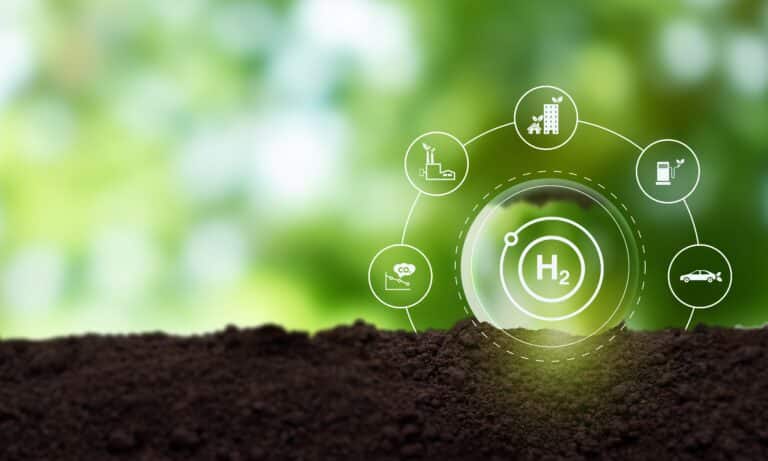This fact sheet represents the research and views of the author. It does not necessarily represent the views of the Center on Global Energy Policy. The piece may be subject to further revision.
Contributions to SIPA for the benefit of CGEP are general use gifts, which gives the Center discretion in how it allocates these funds. More information is available at Our Partners page. Rare cases of sponsored projects are clearly indicated.
Ensuring an effective transition to a net-zero world will require developing and utilizing zero-carbon fuels. One such fuel, hydrogen, has received much attention by governments, investors, and industry both as a zero-carbon fuel and as a zero-carbon feedstock for fuels and products.
Hydrogen gas burns at high temperatures and possesses physical properties that make it relatively easy to handle, with broad application in almost all sectors with only minor retrofits to replace existing fossil fuels. Pure hydrogen or impure hydrogen (blended with other fuels) can be used directly in existing engines, boilers, turbines, and power plants. Synthetic fuels produced from hydrogen, such as ammonia, methanol, and dimethyl ether, have near-zero carbon footprints and in some cases are even carbon removing (net negative). These attributes make hydrogen a potentially important fuel for decarbonization.
Since 1975, global demand for hydrogen has increased more than threefold, to about 70 metric tons[1] in 2019. Most of the hydrogen used today is “grey” hydrogen (produced from fossil fuels). However, as carbon capture, utilization, and sequestration (CCUS) technology becomes more affordable, and cheaper renewable energy becomes more accessible, hydrogen use will progressively become less carbon intensive,[2] what is known as “blue” hydrogen (conventional production coupled with CCUS) or “green” hydrogen (electrolysis of water using renewable energy).[3] As a fuel, it can substitute for other fuels that produce greenhouse gases (GHG) during combustion.
Heavy Industry
Today, the bulk of hydrogen is used in industry as a feedstock for chemicals and refining. The top four industrial uses of hydrogen are for oil refining (33 percent), ammonia production (27 percent), methanol production (11 percent), and steel production (as a chemical reducing agent for iron ore refining, 3 percent).[4] Hydrogen or hydrogen-based fuels can also substitute for solid, liquid, or gaseous fuels in heavy industry, including in the production of chemicals, cement, glass, and steel. Combustion of hydrogen can provide high-quality, low-carbon heat for industrial applications[5] (e.g., melting, gasifying, drying, or catalyzing chemical reactions).
Transportation
Hydrogen, ammonia, and methanol made from low-carbon hydrogen can serve as fuels for internal combustion engines. In some cases, this substitution requires only minor modification of the engines and new tanks, but in most cases substantial modification of existing engines would be needed. In addition, the chemical energy of hydrogen can be converted into electricity using a fuel cell[6] that can run an electric drivetrain for a vehicle. Hydrogen-powered fuel cells can have more than twice the efficiency of traditional combustion technologies, with zero pollution or GHG emissions. An estimated 11,200 hydrogen-powered cars and 20,000 hydrogen forklift trucks are in use today.[7]
Special fueling systems are required for use of hydrogen fuels in transportation. In the United States, there are 60 hydrogen refueling stations, 40 of which are available to the public.[8] The high energy density of liquid hydrogen or ammonia makes them viable fuels for heavy-duty transportation such as long-haul trucks and shipping. Although designs exist for hydrogen planes, the technology is still not advanced and will take decades to commercialize.
Aside from critical technical barriers to fuel cell development—including the cost of component parts and necessary performance and durability improvements—critical infrastructure, such as adequate deployment of refueling stations, is needed for hydrogen to play a significant role in transportation.
Power Generation
Hydrogen can provide dispatchable power that can balance power grid needs and improve grid reliability if large volumes are stored and available. Hydrogen could serve to complement intermittent renewable energy sources such as wind and solar, providing storage as a potential substitute for batteries.[9]
In most natural gas transmission lines, hydrogen can blend safely with natural gas at low concentrations (5 to 20 percent blending rate).[10] While some gas infrastructure can safely accept higher fractions of hydrogen, most gas infrastructure would require major investment or replacement to be compliant with 100 percent hydrogen. Coal power plants can achieve carbon emissions reductions by cofiring liquid ammonia with coal as the feedstock.[11]
Residential Heat
Hydrogen can meet heating needs during peak cold periods. Blending low-carbon hydrogen with existing natural gas networks can reduce the CO2 emitted from building energy use. For buildings currently using natural gas steam systems, hydrogen boilers can offer a lower-carbon heating alternative.[12]
Government policy that would set standards for hydrogen distribution and use (including safety standards) and provide market aligning policies to support hydrogen use (e.g., incentives or direct procurement) could help scale its production and use in different sectors. Additional policies to support hydrogen use include research, development, and deployment grants as well as clarifying regulatory requirements in this space.
Notes
[3] Citi Research, “The Hydrogen Moment—Implications for Industry,” Global Commodity Focus, Citigroup Global Markets Inc., 2021.
[7] Baker McKenzie, “Shaping Tomorrow’s Global Hydrogen Market.”
[8] Citi Research, “The Hydrogen Moment—Implications for Industry.”





